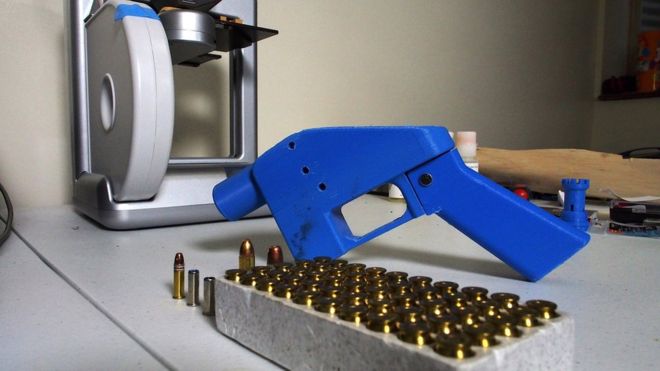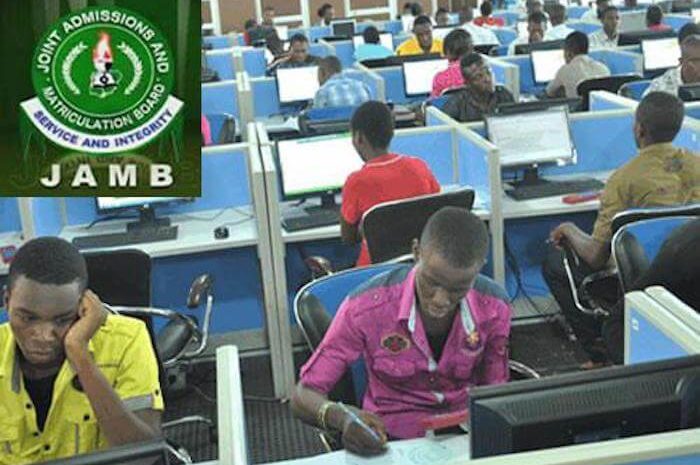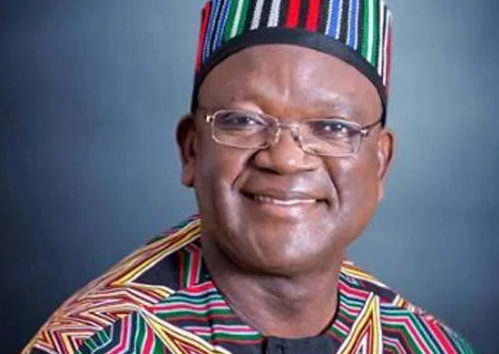A US federal judge in Seattle has blocked the release of software that allows consumers to 3D-print firearms.
Gun access advocacy group Defense Distributed was due to put downloadable gun blueprints online on Wednesday.
The firm reached a settlement with the Trump administration in June to allow it to legally publish the instructions.
But eight states and the District of Columbia sued the government on Monday to block the settlement, arguing the untraceable guns were a safety risk.
US District Judge Robert Lasnik issued a temporary restraining order halting the release hours before the 1 August deadline, saying the blueprints could fall into the wrong hands.
“There are 3D printers in public colleges and public spaces and there is the likelihood of potential irreparable harm,” he said.
Judge Lasnik scheduled another hearing for 10 August.
Although Defense Distributed was expected to publicise the plans on Wednesday, more than 1,000 people have downloaded the files for building an AR-15 rifle – the same gun used in many of America’s mass shootings – since Friday.
The lawsuit against the Trump administration was filed in Seattle, Washington, by the state’s Attorney General Bob Ferguson.
New York, New Jersey, Massachusetts, Connecticut, Pennsylvania, Oregon, Maryland in addition to the District of Columbia are involved.
The complaint calls the 1 August release of gun blueprints “a bell that cannot be un-rung.”
“The Government has made no determination regarding the national security implications of the agreement, or its effects on sovereign US states’ ability to protect the safety of those within their borders.”
In addition, 20 state attorneys general have written to the State Department and Department of Justice about blocking the gun blueprints online.
Speaking outside the court, Washington attorney general Bob Ferguson called the judge’s decision a “complete, total victory.”
“Everything we asked for we got from Judge Lasnik,” he said, and called on President Trump to make it “unlawful for anyone to make this information available for anyone.”
The president had tweeted on Tuesday before the ruling that selling 3D guns to the public “doesn’t seem to make much sense” after settling with Defense Distributed in June.
But the group’s founder Cody Wilson told the BBC the 3D gun was not a threat to public safety.
“I haven’t watched any crimes committed with it,” he said.
“As far as I know only one person’s ever been arrested because of this gun and it was gentleman in Japan who was curious about making it.”
The arguments began in 2013 when Mr. Wilson, a self-styled crypto-anarchist, showed off the world’s first 3D-printed gun.
Files showing how to replicate the process were immediately made available on the Defense Distributed website and downloaded hundreds of thousands of times.
It led the US State Department to order them to be removed from the internet.
There followed a four-year legal battle, with Defense Distributed joining forces with the Second Amendment Foundation – which defends the right to own guns – to sue the State Department.
Last month, in a surprise move, it won its case, with the US Justice Department ruling that Americans may “access, discuss, use and reproduce” the technical data.
Mr. Wilson hailed his victory as the beginning of “the age of the downloadable gun.”
But critics are concerned it will see a massive rise in so-called ghost guns, unregistered weapons the government is unaware of and is unable to trace.
Since the legal action began, Defense Distributed has been working on new gun designs and has also created a milling device – known as Ghost Gunner – that can turn parts purchased online into a fully working weapon.
…………………………………………………………………
Aeroplane crashes in Durango after take-off in Mexico
A plane has crashed in the capital of Mexico’s Durango state, television images show, with the state governor confirming nobody was killed.
Governor José Aispuro tweeted that there were no deaths among the 101 aboard, although around 85 were injured – two critically.
Aeroméxico flight AM2431 was flying from Guadalupe Victoria International Airport to Mexico City.
The plane crashed close to the airport just moments after take-off.
Authorities said that of the 97 passengers and four crew on board, 37 were hospitalised after the crash and two were in a critical condition.
The names and nationalities of those on board were still unknown as at the time of this report.
The airport operator, Grupo Aeroportuario Centro Norte, said early data suggests bad weather was the cause, with the plane taking off during a heavy hailstorm before being forced to make an emergency landing.
Governor Aispuro said witnesses told him there was a “bang”, before the almost full Embraer 190 fell to the ground without warning at around 16:00 local time (21:00 GMT).
One passenger told a local television network it felt like a strong air current hit the aircraft.
Civil defence spokesperson Alejandro Cardoza said a fire which started after the crash was put out, and there were no burn victims.
“Many managed to leave the plane on foot,” Mr. Cardoza said.
All health care bodies in the state were on alert to take care of the injured, the governor said.
Mexican President Enrique Peña Nieto tweeted that he had also instructed federal agencies to help.
Guadalupe Victoria airport was closed after the crash.
In a statement, Aeroméxico said they “deeply regret” the accident, while Brazilian plane company Embraer said they had sent a team to the crash site.
…………………………………………………………………….
US mulls 25% tariff on $200bn of Chinese goods, say reports
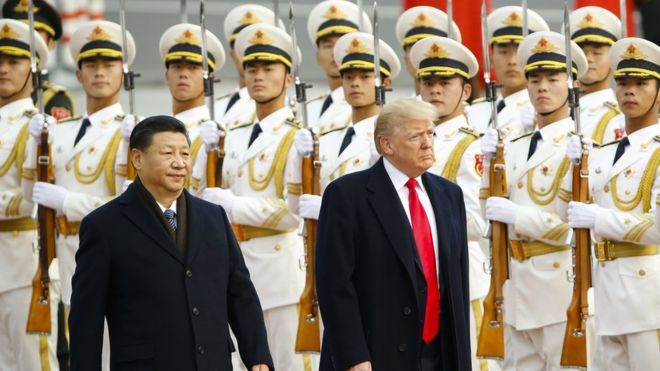
The US is considering 25% tariffs on $200bn (£152bn) of Chinese goods, much higher than the 10% it previously indicated it might impose, reports say.
The plan could be announced as early as Wednesday but a higher tariff was not finalised, sources told US media.
It would risk further escalating tensions between the US and China which are already mired in a trade war.
The US in July published a list of $200bn worth of additional products to be taxed as early as September.
The list named more than 6,000 items including food products, minerals and consumer goods such as handbags.
The US opened fire in a trade war with 25% tariffs on $34bn of Chinese goods, and China retaliated in kind.
US threats have escalated since, with US President Donald Trump saying he is ready to slap tariffs on all $500bn of Chinese imports.
The US accuses China of intellectual copyright theft and wants to bring down its lofty trade deficit with the world’s second largest economy.
But the trade dispute is also seen as part of a broader tug of war between the two powerhouses for influence on the world stage.
On Monday US Secretary of State, Mike Pompeo, announced a plan to spend $113m in Asia, a move that was widely seen as an attempt to counter China’s growing influence in the region.
Bloomberg, which was the first to report the news of the higher tariffs, also said US and Chinese officials were having private conversations as they sought to resume negotiations.
The US is also expected to soon announce tariffs on the remaining $16bn of the $50bn of Chinese goods the US originally planned to tax.
A public hearing on the second round of tariffs took place last week and the USTR has a 31 July deadline for post-hearing comments.
………………………………………………………………………..
Facebook bans pages aimed at US election interference
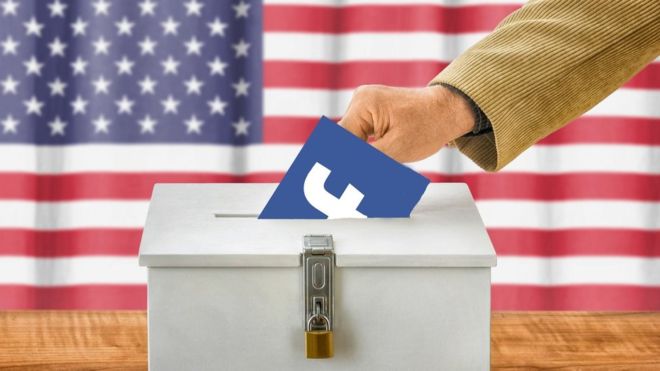
Facebook says it has removed 32 accounts and pages believed to have been set up to influence the mid-term US elections in November.
It said it was in the “very early” stages of the investigation and did not yet know who was behind the pages.
It said the creators had gone to greater lengths to hide their identities than a Russia-based campaign to disrupt the 2016 presidential vote.
It described attempts to erase election interference as an “arms race.”
The social network said in a blog that it had identified 17 suspect profiles on Facebook and seven Instagram accounts.
It said that there were more than 9,500 Facebook posts created by the accounts and one piece of content on Instagram.
In total more than 290,000 accounts followed at least one of the pages involved, it added.
Facebook said the suspect accounts had also run about 150 ads on Facebook and Instagram, costing a total of $11,000 (£8,300).
The most popular fake accounts were:
* Aztlan Warriors
* Black Elevation
* Mindful Being
* Resisters
The “bad actors” went to far greater lengths to cover their tracks than the Russian-based Internet Research Agency (IRA) had in the past, Facebook said.
This included using virtual private networks (VPNs) to hide their location, and using third parties to run ads on their behalf.
Furthermore, the social network said it had not found evidence of Russian IP (internet protocol) addresses.
But it did find one link between the IRA and the new accounts.
One of disabled IRA accounts shared a Facebook event hosted by the Resisters page.
The page also briefly listed an IRA account as one of its administrators.
It added that it “may never be able to identify the source” for the fake accounts.
“The set of actors we see now might be the IRA with improved capabilities, or it could be a separate group,” explained Facebook’s chief security officer Alex Stamos.
“This is one of the fundamental limitations of attribution: offensive organisations improve their techniques once they have been uncovered, and it is wishful thinking to believe that we will always be able to identify persistent actors with high confidence.”
READ ALSO: Konta stuns Serena Williams in San Jose
Facebook has removed the suspect accounts, but says other legitimate page administrators unwittingly interacted with them.
For example, after the Resisters account created a Facebook event for a protest on 10 to 12 August called “No Unite the Right 2”, five other page owners offered to co-host the demonstration and posted details about transportation and locations.
Facebook said it had contacted the admins involved and would alert the 2,600 users who had expressed interest in the event.
